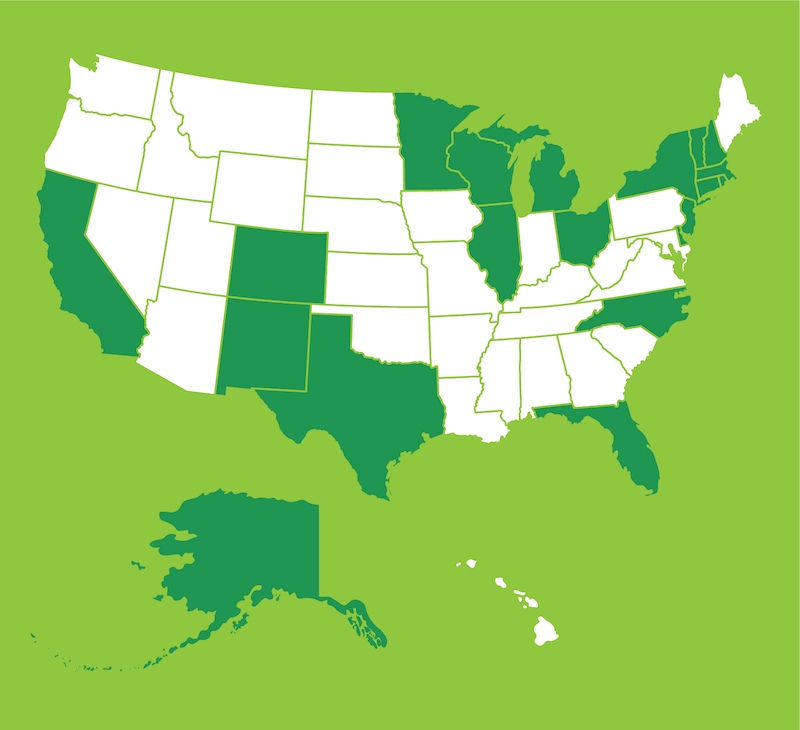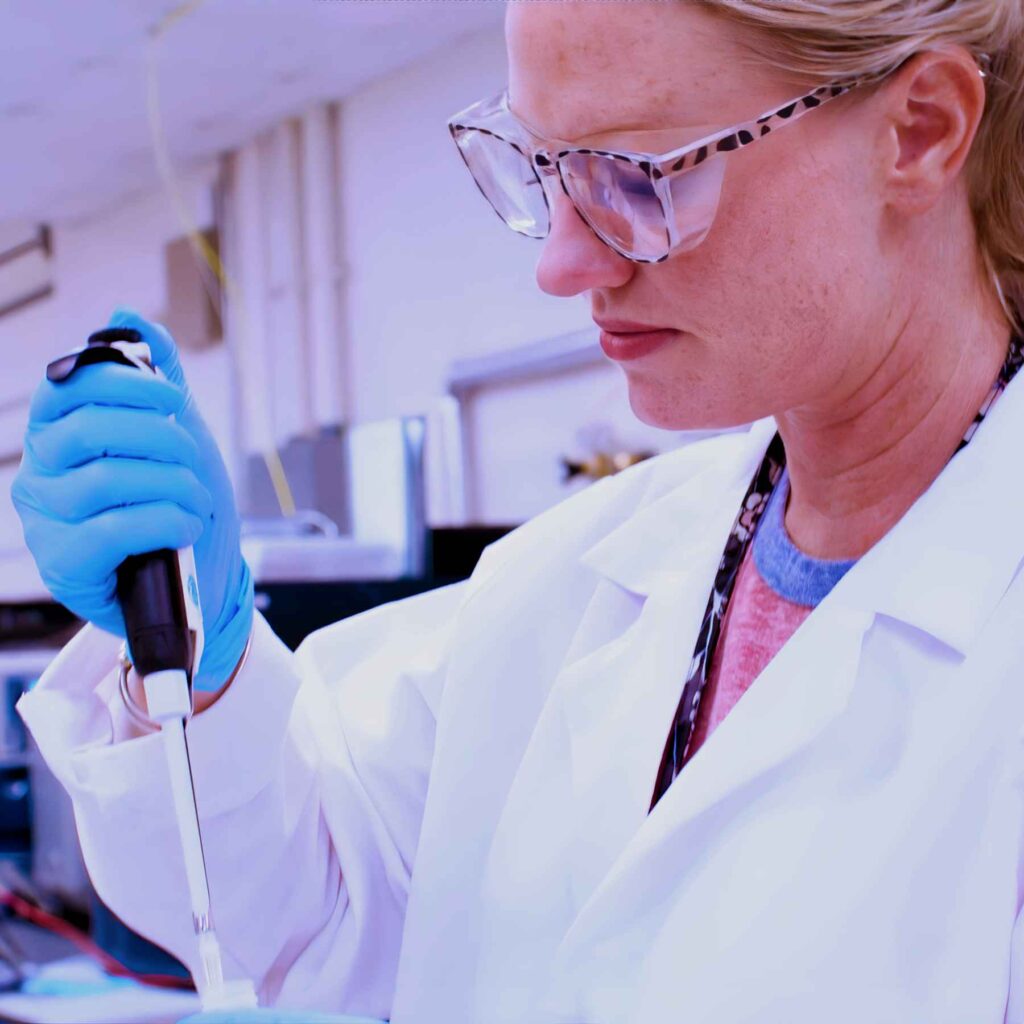PFAS Testing Lab
PFAS: What to know.
Per- and polyfluoroalkyl substances (PFAS) are a group of man-made chemicals in use since the 1940s. This includes perfluorooctanoic acid (PFOA) and perfluorooctanesulfonic acid (PFOS), the two most produced and studied PFAS. Used in a variety of industries around the world, many PFAS are persistent in both humans and the environment, and do not readily break down over time.
Found in a dizzying array of consumer products, most people in the United States have been exposed to one or more PFAS. Current scientific evidence suggests exposure to these chemicals can have adverse health effects for humans including increased cholesterol levels, effects on the immune system, certain cancers, thyroid hormone disruption, and low infant birth weights.
Because PFAS may be released into the air, soil, and water (including drinking water sources), it’s important to understand the level of exposure in both humans and the environment around us. While PFOA and PFOS have received a lot of attention, we can currently analyze up to 75+ different PFAS compounds—and even that only scratches the surface.
As we increase our understanding of the complexity behind these compounds, continuing to test what is in our air, water and soil are more imperative than ever through our PFAS testing analysis. Please contact us for more information regarding our PFAS consulting services.
Why do we test for PFAS?
We have deep PFAS experience.
Sample Matrices
Since we first developed a method for analyzing PFOS in human serum in 2007, we’ve extracted and analyzed tens of thousands of environmental samples for PFAS. And we continue to focus our expertise on testing difficult matrices.
Drinking Water
Most studies on non-worker exposures to PFAS have focused on drinking water as have most existing regulations by various states.
Ground Water
PFAS contamination can seep into the groundwater from areas where firefighting foam was used, discharge from factories or runoff from landfills.
Surface Water
Lakes, rivers, ponds and streams can be contaminated through surface water runoff, or seepage from groundwater.
Soil & Sediment
Soils around the world have been contaminated by PFAS and is a challenging issue due to the differential chemical bonding with soil and sediment depending on the compound.
Biosolids
PFAS have been found in wastewater sludge across the country. Much of this sludge is processed into biosolids and applied to agricultural lands.
Wastewater
PFAS in wastewater at POTWs can originate from a variety of industrial processes and consumer products.
Firefighting Foams
Commonly used as a firefighting agent, legacy PFAS used in AFFF has been linked to various cancers and is a major source of groundwater contamination.
Fabrics
Many fabrics today have a waterproof coating and may still contain PFAS.
Manufactured Products
Fast food wrappers and paperboard typically have a protective layer to keep oils from seeping out of the containers. Fluorotelomer alcohols are often used and are a known precursor to other PFAS of concern.
Fish & Mammalian Tissue
Accumulation of PFAS in wild fish and mammals expose the prevalence of this compound and represent a risk to other wildlife and those species that are used for human consumption.
Milk (Human & Bovine)
PFAS has been found in several dairies around the country as well as in human breast milk.
Plant Tissue
The potential uptake of PFAS in plant tissue, particularly when biosolids are land applied as fertilizer, has become a hot topic and is being studied around the country.
Serum and Biological Fluids
Our experience in analyzing PFAS in human serum dates back to 2007. Today, we analyze for up to 24 PFAS for private individuals, law firms, NGO’s and civilian and military firefighters.
In our long history testing PFAS, we’ve learned how to proficiently handle, extract, and clean samples with large variations in concentrations and interference levels. Without an approved EPA method for non-drinking water matrices, our laboratory has performed hundreds of Quality Control experiments to optimize our analytical procedures—which includes adding an optional centrifuge step for samples high in suspended particulate. We also include 27 labeled standards with our isotope dilution method to increase accuracy, which has become the gold standard for quantitative chemistry.
PFAS Sample Methods & Process
| PFAS Compound Classes | Preservation Methods for Different Matrices |
|---|---|
| For a comprehensive list of the 75+ different PFAS compounds we test, please click here. | If you’d like more information on the specific containers, preservation, and holding times for different matrices, please contact us. |
| Branched & Linear Isomers | Total Oxidizable Precursor (TOP) Assay |
| Early data for many of the water systems around the country only quantified the linear form of PFAS. This ignored the branched forms that can exist for many PFAS and underreported the concentrations of these compounds. Enthalpy quantitates and reports the linear and any branched isomers and can even quantitatively report these separately for five PFAS and qualitatively for the rest of the target PFAS. | While many groups across the country have put pressure on the EPA to standardize the TOP Assay method, there has been no published method to date. In the meantime, many labs either not do perform this analysis or only offer it for very simple, clean matrices. Using the procedure from a 2012 research paper, we can approximate the amount of unknown PFAS precursors that may biotransform to PFCAs and PFSAs of concern. This information is potentially useful for predictive modeling of an impacted site or for evaluating a treatment technology. |
The “States”
of PFAS.

The highlighted states have either an approved regulation or an active proposed regulation which is more restrictive than the USEPA guidance—and could impact the regulatory requirements of facilities. States not highlighted may also have PFAS-related advisories or may be imposing PFAS monitoring requirements or requests.
With this evolving regulatory landscape, it’s important to understand the specific regulations and expectations of agencies in each state. And that’s where you can rely on Enthalpy. Our PFAS experts make it a priority to stay up to date on requirements across the country, to ensure our customers are compliant across federal and state guidelines. If you have a question about testing limits or requirements in your state, please contact us.
Currently, there’s no officially promulgated methods for testing for PFAS in matrices other than drinking water, and only the vaguest of regulations. While we wait for national standards, Enthalpy continues to mine the very best of our deep bench of degreed scientists, and draw on our stringent adherence to best practices, to give you the best and most reliable results.
As our experience testing for PFAS from coast to coast has grown, our involvement with supporting clients in meeting state-specific regulations—and working with municipal, state, and federal agencies—has expanded.
Despite what many think, testing for PFAS is not straightforward. One reason is that many of our standard laboratory materials can themselves contain PFAS, as can the instrumentation. We’ve taken great care to modify our instrumentation and laboratory equipment so they don’t contribute background contamination to the sample results.
Our experience is your quality assurance.
High-Resolution Gas Chromatography & High-Resolution Mass Spectrometry.
UPLC-MS/MS
Per- and Polyfluoroalkyl Substances (PFAS)
-
USEPA Method 537.1
-
USEPA Method 533
-
USEPA Method 1633
-
USEPA 8327 / ASTM D8421
-
USEPA Method 1621 AOF-CIC
-
USEPA OTM-45
-
PFAS Analysis with Isotope Dilution
-
TOP Assay
-
Total Organic Fluorine
Our PFAS labs continually assess available accreditations at the state and federal level to ensure that our methods are not only approved by the appropriate agencies in each location, but also to ensure that our quality systems and methodologies incorporate the latest guidance from across the ever-evolving regulatory landscape. Learn more about our accreditations here.
Accreditations
Work with experts who deliver reliable laboratory data and insights.
Request a quote or email us your analytical testing or permitting question and one of our team members will be in touch shortly!






